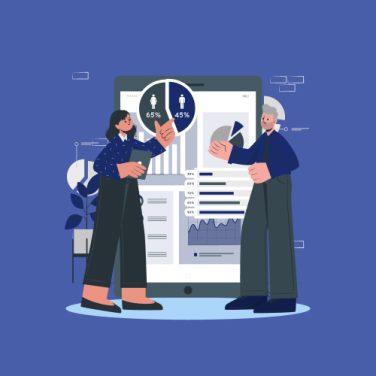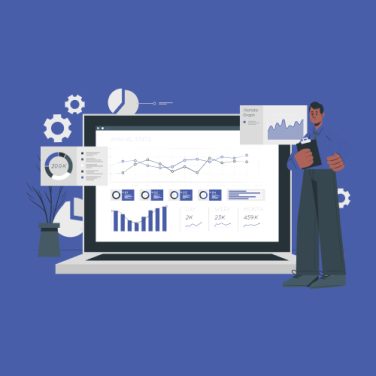Traditionally, HR decisions hinged on intuition or historical reporting. Today, predictive analytics tools analyse turnover risk, hiring pipelines, and productivity metrics to guide workforce planning and diversity initiatives.
This guide explores how people analytics software integrates with HR workflows, highlights the evolution from basic reporting to prescriptive recommendations, and previews MiHCM’s end-to-end analytics ecosystem.
Whether you’re an HR manager, an enterprise director, or evaluating HR analytics solutions, you’ll gain the insights needed to select, implement, and scale an analytics platform aligned to your business goals.
HR analytics tools at a glance
Tool types: Descriptive, diagnostic, predictive, prescriptive analytics.
Core features: Custom dashboards, predictive modelling, AI-driven insights, integration.
Pricing tiers: Free, per-user, enterprise module-based.
Benefits: Improved retention, optimised staffing, data-driven decision-making.
Why MiHCM: Full-stack analytics from MiHCM Lite to MiHCM Enterprise
What are HR analytics tools?
HR analytics tools encompass technologies that gather and analyse workforce data to support strategic decision-making across four analytics types:
- Descriptive analytics: Aggregates historical data to reveal patterns in attendance, performance, and demographics.
- Diagnostic analytics: Identifies root causes via drill-down reporting, uncovering why turnover or engagement shifts occur.
- Predictive analytics: Uses statistical models and machine learning to forecast turnover risk, hiring needs, and performance outcomes.
- Prescriptive analytics: Recommends actionable steps, such as optimal staffing levels or targeted retention programs.
These tools integrate data from HRIS, payroll, applicant tracking systems, and engagement surveys for a unified view. Unlike general HRIS reporting, dedicated people analytics software offers advanced forecasting and AI assistants like MiA for on-demand insights.
How HR analytics tools improve decision making

Linking data insights to HR outcomes transforms reactive processes into proactive strategies. Key impacts include:
- Retention: Predictive models highlight high-risk turnover segments, enabling targeted interventions.
- Engagement: Sentiment analysis of survey responses guides culture and inclusion initiatives.
- Productivity: Dashboards track overtime and utilisation, optimising workforce allocation.
- Staffing: Forecasts align headcount planning with business demand.
Real-time dashboards give HR leaders instant visibility, while SmartAssist AI answers queries on-demand, reducing dependence on BI teams and accelerating decision cycles.
Core features of HR analytics tools
- Customisable dashboards: Build and share visual reports tailored to HR metrics.
- Predictive modelling: Use AI-driven forecasts to anticipate turnover and performance trends.
- Data integration: Seamlessly connect HRIS, payroll, ATS, and engagement platforms.
- Automated alerts: Get notified of anomalies like spikes in absenteeism.
- Self-service portals: Empower non-technical HR users to explore data with SmartAssist and MiA assistants.
These features streamline workforce planning, enhance diversity initiatives, and support evidence-based HR strategies.
Types of HR analytics tools
- Descriptive: Historical aggregation and visualisation—e.g., monthly turnover rates and headcount trends.
- Diagnostic: Root-cause analysis—e.g., drill-down into performance dips by department.
- Predictive: Forecasting—e.g., turnover risk scoring, candidate pipeline timelines.
- Prescriptive: Next-best actions—e.g., automated retention program recommendations.
Organisations often start with descriptive analytics and evolve to predictive and prescriptive capabilities as data maturity grows.
Cost and pricing of HR analytics tools
- Pricing models: Per-user, per-organisation, or module-based licensing.
- Free options: Open-source tools like R and Python offer advanced analytics at no cost but require technical expertise.
- Enterprise platforms: Tiered pricing—from basic dashboards to full AI modules.
- Total cost of ownership: Include implementation, data integration, user training, and support fees.
- Budgeting tips: Small businesses should leverage freemium tiers or MiHCM Lite. Enterprises need enterprise-grade SLAs, global compliance, and MiHCM Enterprise licenses.
How to implement HR analytics tools in your organisation

- Data audit: Catalogue data sources, assess quality, and define governance policies.
- Vendor selection: Evaluate solutions based on features, integration, scalability, and cost.
- Pilot rollout: Start with a single department or module—e.g., turnover forecasting—gather feedback.
- Change management: Communicate benefits, secure executive sponsorship, and align HR processes.
- Training: Upskill HR teams on dashboard use, SmartAssist, and basic analytics concepts.
- Governance and compliance: Ensure data privacy (GDPR, CCPA) and establish audit trails.
A structured roadmap reduces risk and accelerates time-to-value.
Choosing the right HR analytics tool
Small businesses should prioritise:
- Low cost or freemium tiers (e.g., MiHCM Lite).
- Ease of deployment and minimal IT overhead.
- Prebuilt dashboards and basic predictive reports.
Enterprises require:
- Advanced forecasting and prescriptive modules (MiHCM Data & AI).
- Multi-region compliance and global payroll integration (MiHCM Enterprise).
- Customisable BI integrations.
Mid-market organisations often adopt hybrid solutions—mixing ease of use with scalable features.
Open-source tools offer flexibility but demand in-house expertise. Proprietary platforms deliver turnkey solutions with dedicated support.
What is a people analytics platform?
People analytics platforms extend beyond traditional HR analytics by integrating modules like:
- Pulse surveys and sentiment analysis.
- Performance and succession planning insights.
- Learning and talent management data.
Unlike generic HR analytics tools, people analytics platforms focus on behavioural insights and employee experience. They unify engagement, learning, and performance metrics to drive comprehensive workforce strategies.
Which industries benefit most from people analytics?
- Healthcare: Predict staffing needs, reduce overtime costs.
- Retail: Optimise shift planning and seasonal hiring.
- Technology: Forecast turnover among high-value talent.
- Manufacturing: Monitor safety incidents and absenteeism.
- Education: Track faculty performance and retention.
Regulated industries like finance, healthcare, and education benefit from advanced compliance features and audit trails in MiHCM Enterprise.
Integration with HR reporting systems and payroll
- APIs and ETL: Standard integration patterns to sync data between HRIS, payroll, and analytics platforms.
- Data lakes: Central repositories for unstructured and structured HR data.
- Security: End-to-end encryption and audit logs for GDPR and CCPA compliance.
- MiHCM connectors: Prebuilt integrations with major HRIS and payroll systems like Workday, BambooHR, and ADP.
Seamless integration ensures a single source of truth, eliminates data silos, and accelerates analytics adoption.
HR analytics tools for automated reporting

- Report scheduling: Automate recurring reports via email or dashboards.
- Anomaly detection: Instant alerts for data deviations in turnover or absenteeism.
- Embedded analytics: Integrate reports into Slack, Microsoft Teams, or intranet portals.
- SmartAssist use cases: Generate on-demand headcount or performance reports using natural language queries.
Automated reporting frees HR teams from manual exports and ensures stakeholders always have up-to-date insights.
Why choose MiHCM for HR analytics solutions
MiHCM offers a unified analytics suite that scales from small teams to global enterprises:
- Predictive forecasting: Anticipate workforce trends and turnover risk.
- AI-driven guidance: Self-serve insights via natural language queries.
- Modular pricing aligns with company size, from MiHCM Lite to MiHCM Enterprise.
- Built-in global payroll support and compliance.
- 24/7 support and rapid deployment enable fast time-to-value.
These capabilities accelerate decision cycles, reduce manual reporting, and deliver scalable analytics across all HR workflows.
Future trends in HR analytics tools
- Augmented analytics: Natural language queries and auto-generated insights accelerate analysis.
- Wellness data: Integration of health and sentiment metrics shapes holistic employee well-being strategies.
- Prescriptive AI: Automated workflows trigger HR actions like proactive coaching or recruitment.
- Edge computing: Mobile-first analytics enable remote teams to access real-time dashboards.
Adoption of these trends will further embed analytics into daily HR operations, driving continuous improvement.
Mastering HR analytics tools
HR analytics tools are essential for data-driven workforce strategies. From descriptive dashboards to prescriptive AI, these platforms boost retention, optimise staffing, and enhance productivity. Implement with a structured roadmap: audit data, pilot, train teams, and scale.
- Leverage MiHCM’s modular suite—MiHCM Lite to Enterprise—for tailored analytics.
- Use SmartAssist and MiA for on-demand insights without BI support.
- Integrate seamlessly with HRIS, payroll, and engagement systems for a unified view.
Ready to transform your HR processes? Schedule a demo or start a free trial today.



